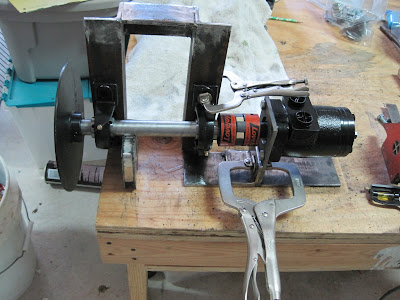 The two halves simply bolt onto the sprocket hub.
The two halves simply bolt onto the sprocket hub.
Now we can get a good idea of exactly where the drive sprocket and hydraulic motor need to be spaced. It looks like there will be plenty of room for everything.

Here is a view from the top.

Now that everything is clamped in place it can be marked for drilling the holes in the frame for the pillow block bearings.

You will notice that the pillow blocks have slotted holes that allow for some adjustment. This is a good thing because all of the components together may not line up exactly as planned and you do not want the jack shaft to be in a bind. You could actually use this slotted hole in conjunction with a drilled slot in the frame and acquire enough movement to tension the chain. That would be entirely acceptable except that you would need to build some adjusters. I prefer to keep it as simple as possible . Once the bearings are bolted in place you do not want any movement. So the question remains as to what method to use in order to tighten or loosen the chain. Let's get the holes drilled for the bearings and then look at a method for adjusting the chain.

I like to use a smaller drill bit to spot the correct location of a larger hole that needs to be drilled because it is easier to see if the drill bit is in the exact spot you want to drill.

Once the hole location is spotted and the piece is bolted securely in place then change out the smaller drill bit for the finish size bit and the hole can be drilled exactly where you want it.

You will notice in the next photo that the color of the frame is lighter and all of the rust has been removed. The sand blast cabinet was open so I threw it in and blasted it for a couple of minutes.
 Now back to the chain adjustment. Since there are two bearings it would be necessary to move both bearings equally in order to adjust the chain tension. These bearings need to be in perfect alignment with each other and the hydraulic motor in order to move smoothly and minimize wear. I like the idea of bolting everything firmly in proper alignment and using an independent means for adjusting the chain. I was discussing this with my good friend and engineer Jim Chitwood of Chitwood Engineers. He suggested that I use a chain tensioner. WOW! That is a great idea. Jim once designed a water jet cutting machine that we built together. That could be the subject of another Blog. So I go to the Graingers catalog to find a chain tensioner. Whoa!! One hundred dollars and that doesn't even include the idler sprocket and shaft. So let's get back to reality here. A chain tensioner is nothing more than a simple way to put pressure on the chain in order to take up excessive slack. It consists of an arm with an idler sprocket attached that can be pushed against the chain and bolted into place. I had already fabricated a simple assembly for this purpose but it would not fit properly into the hole that I drilled as you can see in the next photo.
Now back to the chain adjustment. Since there are two bearings it would be necessary to move both bearings equally in order to adjust the chain tension. These bearings need to be in perfect alignment with each other and the hydraulic motor in order to move smoothly and minimize wear. I like the idea of bolting everything firmly in proper alignment and using an independent means for adjusting the chain. I was discussing this with my good friend and engineer Jim Chitwood of Chitwood Engineers. He suggested that I use a chain tensioner. WOW! That is a great idea. Jim once designed a water jet cutting machine that we built together. That could be the subject of another Blog. So I go to the Graingers catalog to find a chain tensioner. Whoa!! One hundred dollars and that doesn't even include the idler sprocket and shaft. So let's get back to reality here. A chain tensioner is nothing more than a simple way to put pressure on the chain in order to take up excessive slack. It consists of an arm with an idler sprocket attached that can be pushed against the chain and bolted into place. I had already fabricated a simple assembly for this purpose but it would not fit properly into the hole that I drilled as you can see in the next photo.
So forget that. All we need is a 3/4" nut welded onto the upright of the frame so that the tensioner can be bolted in place.































